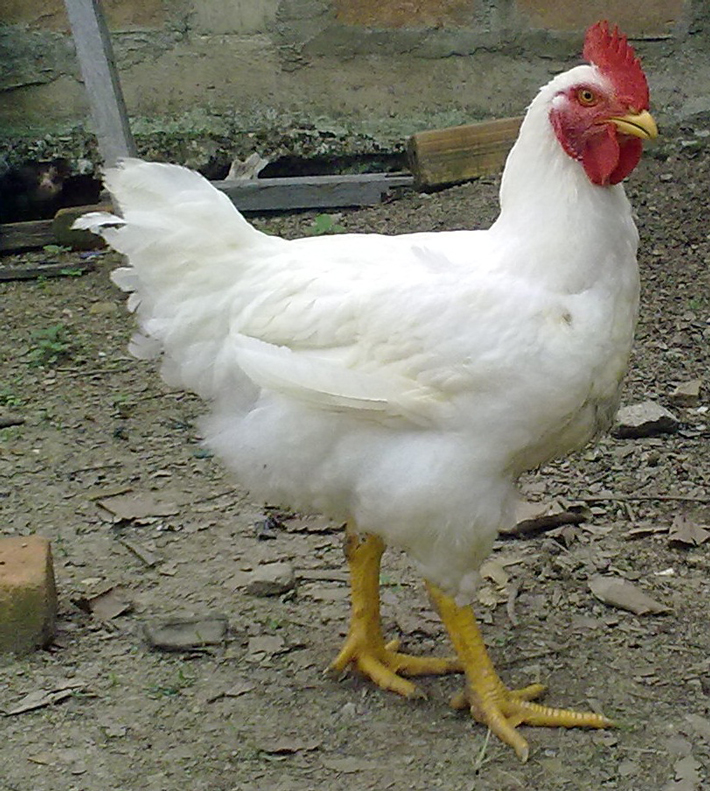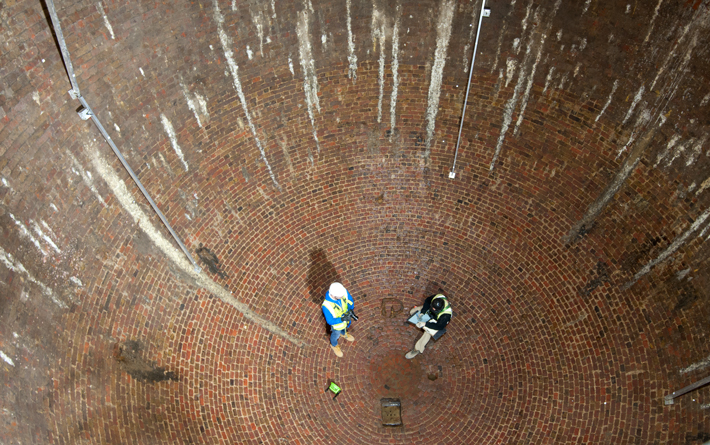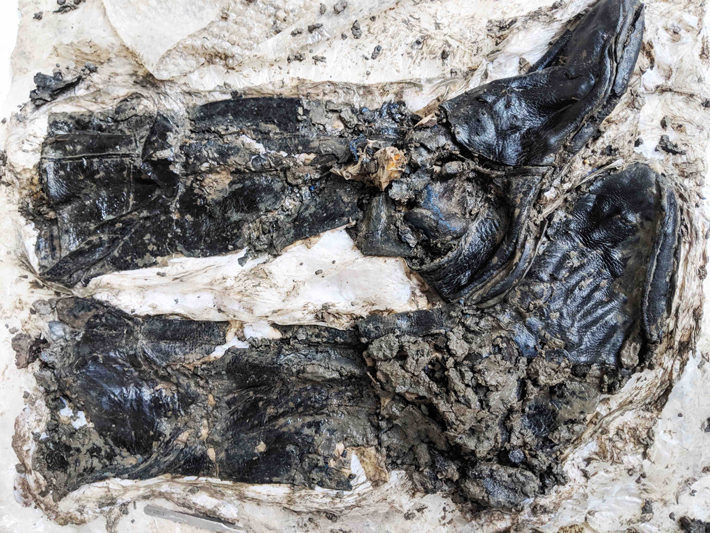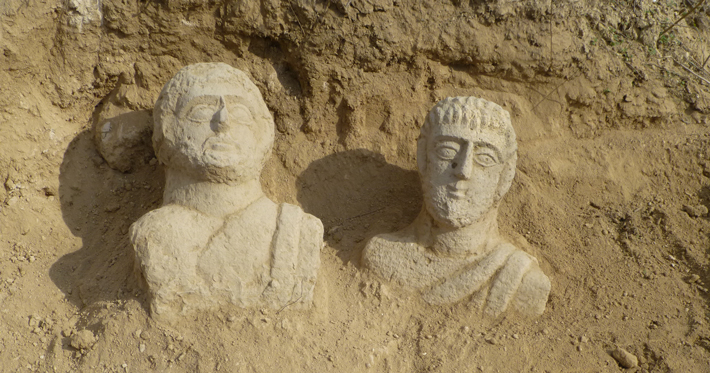From the Trenches
The Chicken People
By ZACH ZORICH
Friday, February 08, 2019
 When future archaeologists excavate sites dating to the late twentieth and early twenty-first centuries, what will define our era won’t be the smartphone, the plastic straw, or any other artificial product of our throwaway culture. It will instead be the bones of broiler chickens, argues a group of scholars from the United Kingdom and South Africa who have compared the size of chickens over time from Roman Britain to the present day. The results show that chickens gradually increased in size for almost 2,000 years until about 1950, when broiler chickens—those raised to provide meat rather than eggs—started to get huge. Compared with the Asian red jungle fowl, from which they have evolved, modern broilers are positively gargantuan. At the time of slaughter, they can be twice the weight of their Asian forebears. The researchers attribute this rapid size expansion to a breeding program called “Chicken of Tomorrow” that was launched in the midtwentieth century by the U.S. Department of Agriculture in partnership with private business. The program’s goal was to increase meat production. Today, more than 65.8 billion chickens are eaten each year by the world’s growing human population. All these chickens’ skeletons end up in landfills, a prime location to wait out the millennia for future excavators.
When future archaeologists excavate sites dating to the late twentieth and early twenty-first centuries, what will define our era won’t be the smartphone, the plastic straw, or any other artificial product of our throwaway culture. It will instead be the bones of broiler chickens, argues a group of scholars from the United Kingdom and South Africa who have compared the size of chickens over time from Roman Britain to the present day. The results show that chickens gradually increased in size for almost 2,000 years until about 1950, when broiler chickens—those raised to provide meat rather than eggs—started to get huge. Compared with the Asian red jungle fowl, from which they have evolved, modern broilers are positively gargantuan. At the time of slaughter, they can be twice the weight of their Asian forebears. The researchers attribute this rapid size expansion to a breeding program called “Chicken of Tomorrow” that was launched in the midtwentieth century by the U.S. Department of Agriculture in partnership with private business. The program’s goal was to increase meat production. Today, more than 65.8 billion chickens are eaten each year by the world’s growing human population. All these chickens’ skeletons end up in landfills, a prime location to wait out the millennia for future excavators.
Ice Merchants
By DANIEL WEISS
Friday, February 08, 2019
 A large, egg-shaped ice house has been unearthed near Regent’s Park in London. The brick-lined underground structure, which measures 31 feet high and 23 feet wide, was built in the 1780s. “This was one of the earliest and largest commercial ice wells,” says David Sorapure, head of built heritage at Museum of London Archaeology. “Previously, ice had been something of a luxury, available only at aristocratic estates.” Among those who took advantage of the novel amenity were restaurants, private residents, and local doctors, who likely used it to help dull patients’ pain.
A large, egg-shaped ice house has been unearthed near Regent’s Park in London. The brick-lined underground structure, which measures 31 feet high and 23 feet wide, was built in the 1780s. “This was one of the earliest and largest commercial ice wells,” says David Sorapure, head of built heritage at Museum of London Archaeology. “Previously, ice had been something of a luxury, available only at aristocratic estates.” Among those who took advantage of the novel amenity were restaurants, private residents, and local doctors, who likely used it to help dull patients’ pain.
Die With Your Boots On
By MARLEY BROWN
Friday, February 08, 2019
 A pair of thigh-high leather boots that belonged to a man who died near the Thames River in southeast London some 500 years ago offers a rare glimpse of medieval work wear. Archaeological surveys conducted ahead of an overhaul of London’s sewer system unearthed the man’s skeleton—boots on, face down—in a deposit of mud on the river’s south bank. “While the boots may not have been prohibitively expensive for a working-class individual, they were well made and built to last,” says Beth Richardson, senior finds specialist for Museum of London Archaeology Headland Infrastructure. The height of the boots, a rarity for the period, indicates that the man made his living on the river, possibly as a fisherman, mud lark, or sailor. Researchers have turned up no evidence of foul play relating to his death, so whether he drowned after misjudging a current, suffered an injury, or fell into the river remains unclear.
A pair of thigh-high leather boots that belonged to a man who died near the Thames River in southeast London some 500 years ago offers a rare glimpse of medieval work wear. Archaeological surveys conducted ahead of an overhaul of London’s sewer system unearthed the man’s skeleton—boots on, face down—in a deposit of mud on the river’s south bank. “While the boots may not have been prohibitively expensive for a working-class individual, they were well made and built to last,” says Beth Richardson, senior finds specialist for Museum of London Archaeology Headland Infrastructure. The height of the boots, a rarity for the period, indicates that the man made his living on the river, possibly as a fisherman, mud lark, or sailor. Researchers have turned up no evidence of foul play relating to his death, so whether he drowned after misjudging a current, suffered an injury, or fell into the river remains unclear.
After the Rain
By DANIEL WEISS
Friday, February 08, 2019
 Israel Antiquities Authority archaeologists have investigated a site near the town of Beth Shean where a hiker spotted a rare limestone funerary bust dating to the third or fourth century A.D. poking out of the ground after a rainstorm. There, the archaeologists uncovered a second bust as well. Only a few dozen such busts are known. These are the first examples to have been found marking the graves for which they were sculpted.
Israel Antiquities Authority archaeologists have investigated a site near the town of Beth Shean where a hiker spotted a rare limestone funerary bust dating to the third or fourth century A.D. poking out of the ground after a rainstorm. There, the archaeologists uncovered a second bust as well. Only a few dozen such busts are known. These are the first examples to have been found marking the graves for which they were sculpted.
The Magic Mineral
By JASON URBANUS
Friday, February 08, 2019
 To the Greeks and Romans, a red pigment known as miltos was a sort of multipurpose supersubstance. Ancient writers, from Theophrastus to Pliny, record that the finegrained, red iron oxide–based material was much sought after for use in decoration, cosmetics, agriculture, medicine, and even boat maintenance. A new study indicates that one of the reasons miltos was so versatile is that not all miltos was created equal.
To the Greeks and Romans, a red pigment known as miltos was a sort of multipurpose supersubstance. Ancient writers, from Theophrastus to Pliny, record that the finegrained, red iron oxide–based material was much sought after for use in decoration, cosmetics, agriculture, medicine, and even boat maintenance. A new study indicates that one of the reasons miltos was so versatile is that not all miltos was created equal.
An international team analyzed the mineralogy, geochemistry, and even microbiology of miltos samples recovered from the Greek islands of Kea and Lemnos, and has been able to identify subtle variations that made each sample suitable for a particular use. “Different sources produced different types of miltos,” says University of Glasgow archaeologist Effie Photos-Jones. “It was not a pure mineral but rather a combination of minerals. There are also variations in the microorganisms that live in the immediate vicinity of those minerals.” For example, some Kea miltos samples contain microorganisms that would have enhanced their use as a fertilizer. Others contain high concentrations of lead, which could help prevent growth of harmful biofilms and barnacles on ships’ hulls. One sample from Lemnos has traces of titanium dioxide, a known antibacterial compound, making it useful for medicinal purposes.
Advertisement
Advertisement
IN THIS ISSUE
From the Trenches
Fairfield's Rebirth in 3-D
Off the Grid
Reburial in Luxor
Mild Boars
Foreign Funeral Rites
The Magic Mineral
Die With Your Boots On
After the Rain
Ice Merchants
The Chicken People
Honoring the Ancestors
Ahead of His Time
Celtic Trophy Heads
A Ride to Valhalla
India's Temple Island
World Roundup
English food culture, Japanese weevils, the Sri Lankan spice trade, and surviving the Tibetan Plateau
Artifact
A lady’s circle of influence
Advertisement

Recent Issues
-
 May/June 2024
May/June 2024
-
 March/April 2024
March/April 2024
-
 January/February 2024
January/February 2024
-
 November/December 2023
November/December 2023
-
 September/October 2023
September/October 2023
-
 July/August 2023
July/August 2023
-
 May/June 2023
May/June 2023
-
 March/April 2023
March/April 2023
-
 January/February 2023
January/February 2023
-
 November/December 2022
November/December 2022
-
 September/October 2022
September/October 2022
-
 July/August 2022
July/August 2022
-
 May/June 2022
May/June 2022
-
 March/April 2022
March/April 2022
-
 January/February 2022
January/February 2022
-
 November/December 2021
November/December 2021
-
 September/October 2021
September/October 2021
-
 July/August 2021
July/August 2021
-
 May/June 2021
May/June 2021
-
 March/April 2021
March/April 2021
-
 January/February 2021
January/February 2021
-
 November/December 2020
November/December 2020
-
 September/October 2020
September/October 2020
-
 July/August 2020
July/August 2020
-
 May/June 2020
May/June 2020
-
 March/April 2020
March/April 2020
-
 January/February 2020
January/February 2020
-
 November/December 2019
November/December 2019
-
 September/October 2019
September/October 2019
-
 July/August 2019
July/August 2019
-
 May/June 2019
May/June 2019
-
 March/April 2019
March/April 2019
-
 January/February 2019
January/February 2019
-
 November/December 2018
November/December 2018
-
 September/October 2018
September/October 2018
-
 July/August 2018
July/August 2018
-
 May/June 2018
May/June 2018
-
 March/April 2018
March/April 2018
-
 January/February 2018
January/February 2018
-
 November/December 2017
November/December 2017
-
 September/October 2017
September/October 2017
-
 July/August 2017
July/August 2017
-
 May/June 2017
May/June 2017
-
 March/April 2017
March/April 2017
-
 January/February 2017
January/February 2017
-
 November/December 2016
November/December 2016
-
 September/October 2016
September/October 2016
-
 July/August 2016
July/August 2016
-
 May/June 2016
May/June 2016
-
 March/April 2016
March/April 2016
-
 January/February 2016
January/February 2016
-
 November/December 2015
November/December 2015
-
 September/October 2015
September/October 2015
-
 July/August 2015
July/August 2015
-
 May/June 2015
May/June 2015
-
 March/April 2015
March/April 2015
-
 January/February 2015
January/February 2015
-
 November/December 2014
November/December 2014
-
 September/October 2014
September/October 2014
-
 July/August 2014
July/August 2014
-
 May/June 2014
May/June 2014
-
 March/April 2014
March/April 2014
-
 January/February 2014
January/February 2014
-
 November/December 2013
November/December 2013
-
 September/October 2013
September/October 2013
-
 July/August 2013
July/August 2013
-
 May/June 2013
May/June 2013
-
 March/April 2013
March/April 2013
-
 January/February 2013
January/February 2013
-
 November/December 2012
November/December 2012
-
 September/October 2012
September/October 2012
-
 July/August 2012
July/August 2012
-
 May/June 2012
May/June 2012
-
 March/April 2012
March/April 2012
-
 January/February 2012
January/February 2012
-
 November/December 2011
November/December 2011
-
 September/October 2011
September/October 2011
-
 July/August 2011
July/August 2011
-
 May/June 2011
May/June 2011
-
 March/April 2011
March/April 2011
-
 January/February 2011
January/February 2011
Advertisement






